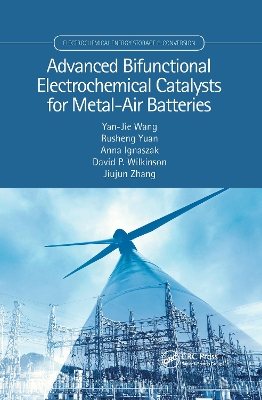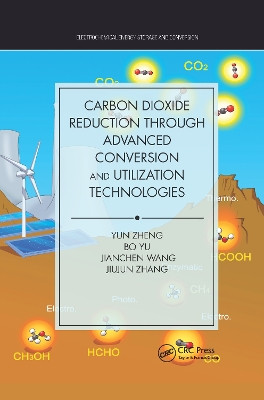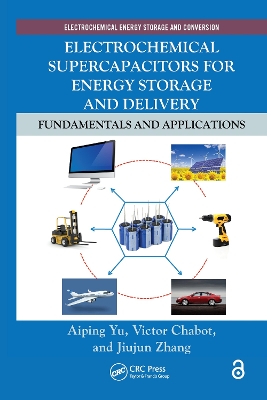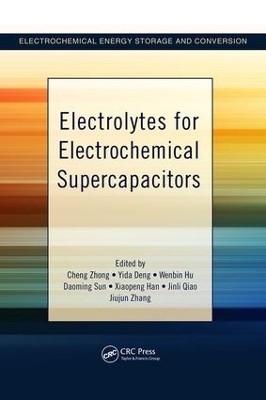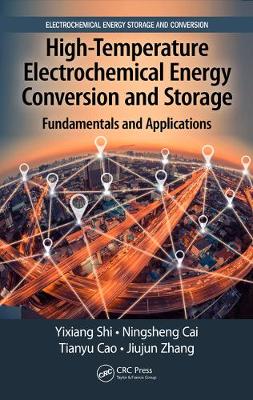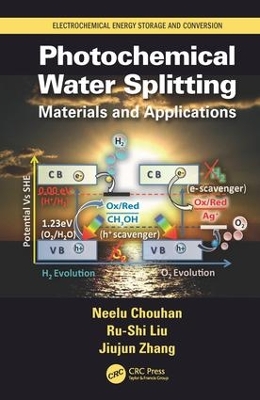Electrochemical Energy Storage and Conversion
7 total works
This book comprehensively reviews environmental issues related to electrochemical energy technologies. Fundamental science of electrochemical engineering and environmental engineering will be introduced. It also provides an understanding of the technologies and their impact on environment, helping readers develop more environmentally friendly designs. Major environmental issues related to electrochemical energy such as used batteries will be reviewed. State-of-the-art technical information and effective strategies about electrochemical energy and environment will be provided to readers at all academic levels.
Advanced Bifunctional Electrochemical Catalysts for Metal-Air Batteries
by Yan-Jie Wang, Rusheng Yuan, Anna Ignaszak, David P. Wilkinson, and Jiujun Zhang
Metal-air batteries (MABs) have attracted attention because of their high specific energy, low cost, and safety features. This book discusses science and technology including material selection, synthesis, characterization, and their applications in MABs. It comprehensively describes various composite bifunctional electrocatalysts, corrosion/oxidation of carbon-containing air cathode catalysts, and how improvements can be achieved in the catalytic activities of oxygen reduction reaction and oxygen evolution reaction and their durability/stability. This book also analyzes, compares, and discusses composite bifunctional electrocatalysts in the applications of MABs, matching the fast information of commercial MABs in requirements.
Aimed at researchers and industry professionals, this comprehensive work provides readers with an appreciation for what bifunctional composite electrocatalysts are capable of, how this field has grown in the past decades, and how bifunctional composite electrocatalysts can significantly improve the performance of MABs. It also offers suggestions for future research directions to overcome technical challenges and further facilitate research and development in this important area.
Carbon Dioxide Reduction through Advanced Conversion and Utilization Technologies
by Yun Zheng, Bo Yu, Jianchen Wang, and Jiujun Zhang
Carbon Dioxide Reduction through Advanced Conversion and Utilization Technologies covers fundamentals, advanced conversion technologies, economic feasibility analysis, and future research directions in the field of CO2 conversion and utilization.
This book emphasizes principles of various conversion technologies for CO2 reduction such as enzymatic conversion, mineralization, thermochemical, photochemical, and electrochemical processes. It addresses materials, components, assembly and manufacturing, degradation mechanisms, challenges, and development strategies. Applications of conversion technologies for CO2 reduction to produce useful fuels and chemicals in energy and industrial systems are discussed as solutions to reduce greenhouse effects and energy shortages. Particularly, the advanced materials and technology of high temperature co-electrolysis of H2O and CO2 to produce sustainable fuels using solid oxide cells (SOCs) are reviewed and the introduction, fundamentals, and some significant topics regarding this CO2 conversion process are discussed.
This book provides a comprehensive and clear picture of advanced technologies in CO2 conversion and utilization. Written in a clear and detailed manner, it is suitable for students as well as industry professionals, researchers, and academics.
Electrochemical Supercapacitors for Energy Storage and Delivery
by Aiping Yu, Victor Chabot, and Jiujun Zhang
Although recognized as an important component of all energy storage and conversion technologies, electrochemical supercapacitators (ES) still face development challenges in order to reach their full potential. A thorough examination of development in the technology during the past decade, Electrochemical Supercapacitors for Energy Storage and Delivery: Fundamentals and Applications provides a comprehensive introduction to the ES from technical and practical aspects and crystallization of the technology, detailing the basics of ES as well as its components and characterization techniques.
The book illuminates the practical aspects of understanding and applying the technology within the industry and provides sufficient technical detail of newer materials being developed by experts in the field which may surface in the future. The book discusses the technical challenges and the practical limitations and their associated parameters in ES technology. It also covers the structure and options for device packaging and materials choices such as electrode materials, electrolyte, current collector, and sealants based on comparison of available data.
Supplying an in depth understanding of the components, design, and characterization of electrochemical supercapacitors, the book has wide-ranging appeal to industry experts and those new to the field. It can be used as a reference to apply to current work and a resource to foster ideas for new devices that will further the technology as it becomes a larger part of main stream energy storage.
Electrolytes for Electrochemical Supercapacitors
by Cheng Zhong, Yida Deng, Wenbin Hu, Daoming Sun, Xiaopeng Han, Jinli Qiao, and Jiujun Zhang
High-Temperature Electrochemical Energy Conversion and Storage
by Yixiang Shi, Ningsheng Cai, Tianyu Cao, and Jiujun Zhang
As global demands for energy and lower carbon emissions rise, developing systems of energy conversion and storage becomes necessary. This book explores how Electrochemical Energy Storage and Conversion (EESC) devices are promising advanced power systems that can directly convert chemical energy in fuel into power, and thereby aid in proposing a solution to the global energy crisis. The book focuses on high-temperature electrochemical devices that have a wide variety of existing and potential applications, including the creation of fuel cells for power generation, production of high-purity hydrogen by electrolysis, high-purity oxygen by membrane separation, and various high-temperature batteries. High-Temperature Electrochemical Energy Conversion and Storage: Fundamentals and Applications provides a comprehensive view of the new technologies in high-temperature electrochemistry. Written in a clear and detailed manner, it is suitable for developers, researchers, or students of any level.
Photochemical Water Splitting
by Neelu Chouhan, Ru-Shi Liu, and Jiujun Zhang
Cleavage of water to its constituents (i.e., hydrogen and oxygen) for production of hydrogen energy at an industrial scale is one of the "holy grails" of materials science. That can be done by utilizing the renewable energy resource i.e. sunlight and photocatalytic material. The sunlight and water are abundant and free of cost available at this planet. But the development of a stable, efficient and cost-effective photocatalytic material to split water is still a great challenge. To develop the effective materials for photocatalytic water splitting, various type of materials with different sizes and structures from nano to giant have been explored that includes metal oxides, metal chalcogenides, carbides, nitrides, phosphides, and so on. Fundamental concepts and state of art materials for the water splitting are also discussed to understand the phenomenon/mechanism behind the photoelectrochemical water splitting. This book gives a comprehensive overview and description of the manufacturing of photocatalytic materials and devices for water splitting by controlling the chemical composition, particle size, morphology, orientation and aspect ratios of the materials. The real technological breakthroughs in the development of the photoactive materials with considerable efficiency, are well conversed to bring out the practical aspects of the technique and its commercialization.

